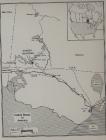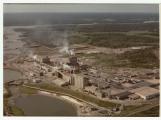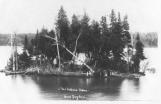1
Pollution to water systems and air is often the darker reality of modern the pulp and paper industry. Whereas most companies employ a solid environmental protection plan in their operations, there are a few who have failed and have caused major polluting of their area's natural resources.3
When the pulp and paper mill in Dryden was under the ownership of Reed Paper Limited there was major environmental damage down the Wabigoon and English River system. Reed Paper Limited owned and operated the mill from 1960-1979 when mercury was being released into the water. The residents of Dryden escaped the effect of the toxins however; the people of Grassy Narrows and Whitedog First Nations were unable too.High levels of mercury in fish and wildlife around Grassy Narrows and Whitedog were found, but it wasn't until 1970 that the fish from the river were condemned. When animals were tested for mercury levels it was found that they had levels of mercury 15 times higher than animals that used other river systems. A pike had approximately 2.31 to 5.18 parts per million (ppm) of mercury in its system, walleye 1.58 to 5.98 ppm and whitefish contained 0.47 to 2.01 ppm of mercury. After a series of tests it was concluded that mercury cathode chlor-alkali, a chemical used in the bleaching process of paper was being spewed, at 40,000 pounds per month into the environment. 20,000 pounds were leaking into the water system through non-point source pollution while the other 20,000 was being released into the air.
5
Concessions were made so that in 1970 all mercury excretions were curtailed and by 1971 there was to be a system installed that prevented metals from running into the Wabigoon /English River system. However, metals continued to be released in the air until 1975.After it was confirmed that mercury was leaking into the wild life, Reed Limited quickly denied the accusations claiming the mercury leakage was coming from the Canadian Shield. The government dismissed the claim forcing Reed to take responsibility of their actions. However, the company refused saying it was society's responsibility to take care of the environment not the company's.
7
Regardless of the debate over who is responsible for the pollution, the people of Grassy Narrows were beginning to experience the effects of mercury. Eighty-seven people of the total number tested had levels of mercury exceeding 100 ppb. Yet, it was difficult to pinpoint exactly if their ailments were due to the mercury for three reasons. The first reason being there was no consensus of what were symptoms of mercury exposure. Secondly, the pattern of exposure varied between person and finally the damage mercury causes may not be limited to the organic body. These three factors made it difficult for the government to conclusively state the illnesses residents of Grassy Narrows were experiencing were directly related to the mercury present in the water.With the presence of mercury in the water the residents found it difficult to live a traditional Ojibwa lifestyle. Most people depended on the fishing industry for there income, when the mercury contamination forced the closure of the industry many people did not understand how the river was polluting the fish. Explaining the situation was made difficult, as it was impossible to physically show the chemical that had seeped into the water system from Dryden. Furthering the situation was the financial loss with the closing of the fisheries and their dismal future. It was expected that commercial fishing would not be able to be re-opened for 50 to 70 years. Therefore, forgivable loans of $31,108 were given to nineteen fishermen to act as unemployment insurance. This insufficient amount of money was given by the Provincial government not the culprit, Reed Paper Company. The money doled out did not cover life's necessities. Fish was the major source of food during the summer months, becoming a staple for many families. The Ontario government again attempted to compensate to the people by creating a fish for food program. Frozen fish was shipped into the community and made available to all band members. This program only solved a portion of the problem; the people were unemployed and required new employment opportunities.
It was not until 1976 that the newly developed Canada-Ontario Mercury Committee met to discuss possible employment opportunities for both Grassy Narrows and Whitedog. In 1977, seven years after the discovery of mercury, funds were developed to create employment; logging, life skills, daycare and travel expenses to learn about the effects of mercury poisoning.



